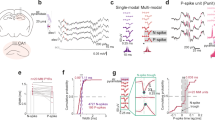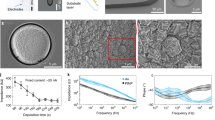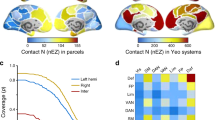Abstract
The electrochemical processes that underlie neural function manifest themselves in ceaseless spatiotemporal field fluctuations. However, extracellular fields feed back onto the electric potential across the neuronal membrane via ephaptic coupling, independent of synapses. The extent to which such ephaptic coupling alters the functioning of neurons under physiological conditions remains unclear. To address this question, we stimulated and recorded from rat cortical pyramidal neurons in slices with a 12-electrode setup. We found that extracellular fields induced ephaptically mediated changes in the somatic membrane potential that were less than 0.5 mV under subthreshold conditions. Despite their small size, these fields could strongly entrain action potentials, particularly for slow (<8 Hz) fluctuations of the extracellular field. Finally, we simultaneously measured from up to four patched neurons located proximally to each other. Our findings indicate that endogenous brain activity can causally affect neural function through field effects under physiological conditions.
This is a preview of subscription content, access via your institution
Access options
Subscribe to this journal
Receive 12 print issues and online access
$209.00 per year
only $17.42 per issue
Buy this article
- Purchase on Springer Link
- Instant access to full article PDF
Prices may be subject to local taxes which are calculated during checkout




Similar content being viewed by others
References
Koch, C. Biophysics of Computation (Oxford University Press, 1999).
Stuart, G., Spruston, N. & Hausser, M. Dendrites (Oxford University Press, 2008).
Haider, B. & McCormick, D.A. Rapid neocortical dynamics: cellular and network mechanisms. Neuron 62, 171–189 (2009).
Gold, C., Henze, D.A., Koch, C. & Buzsáki, G. On the origin of the extracellular action potential waveform: a modeling study. J. Neurophysiol. 95, 3113–3128 (2006).
Pettersen, K.H. & Einevoll, G.T. Amplitude variability and extracellular low-pass filtering of neuronal spikes. Biophys. J. 94, 784–802 (2008).
Steriade, M., Nunez, A. & Amzica, F. A novel slow (< 1 Hz) oscillation of neocortical neurons in vivo: depolarizing and hyperpolarizing components. J. Neurosci. 13, 3252–3265 (1993).
Steriade, M., Nunez, A. & Amzica, F. Intracellular analysis of relations between the slow (<1 Hz) neocortical oscillation and other sleep rhythms of the electroencephalogram. J. Neurosci. 13, 3266–3283 (1993).
Vanderwolf, C.H. Hippocampal electrical activity and voluntary movement in the rat. Electroencephalogr. Clin. Neurophysiol. 26, 407–418 (1969).
Buzsáki, G., Leung, L.W. & Vanderwolf, C.H. Cellular bases of hippocampal EEG in the behaving rat. Brain Res. 287, 139–171 (1983).
Buzsáki, G. Theta oscillations in the hippocampus. Neuron 33, 325–340 (2002).
Lubenov, E.V. & Siapas, A.G. Hippocampal theta oscillations are travelling waves. Nature 459, 534–539 (2009).
Buzsáki, G., Horvath, Z., Urioste, R., Hetke, J. & Wise, K. High-frequency network oscillation in the hippocampus. Science 256, 1025–1027 (1992).
Ylinen, A. et al. Sharp wave–associated high-frequency oscillation (200 Hz) in the intact hippocampus: network and intracellular mechanisms. J. Neurosci. 15, 30–46 (1995).
Arvanitaki, A. Effects evoked in an axon by the activity of a contiguous one. J. Neurophysiol. 5, 89–108 (1942).
Traub, R.D., Dudek, F.E., Taylor, C.P. & Knowles, W.D. Simulation of hippocampal afterdischarges synchronized by electrical interactions. Neuroscience 14, 1033–1038 (1985).
Chan, C.Y. & Nicholson, C. Modulation by applied electric fields of Purkinje and stellate cell activity in the isolated turtle cerebellum. J. Physiol. (Lond.) 371, 89–114 (1986).
Jefferys, J.G. Nonsynaptic modulation of neuronal activity in the brain: electric currents and extracellular ions. Physiol. Rev. 75, 689–723 (1995).
Radman, T., Su, Y., An, J.H., Parra, L.C. & Bikson, M. Spike timing amplifies the effect of electric fields on neurons: implications for endogenous field effects. J. Neurosci. 27, 3030–3036 (2007).
Deans, J.K., Powell, A.D. & Jefferys, J.G. Sensitivity of coherent oscillations in rat hippocampus to AC electric fields. J. Physiol. 583, 555–565 (2007).
Anastassiou, C.A., Montgomery, S.M., Barahona, M., Buzsáki, G. & Koch, C. The effect of spatially inhomogeneous extracellular electric fields on neurons. J. Neurosci. 30, 1925–1936 (2010).
Chan, C.Y., Hounsgaard, J. & Nicholson, C. Effects of electric fields on transmembrane potential and excitability of turtle cerebellar Purkinje cells in vitro. J. Physiol. (Lond.) 402, 751–771 (1988).
Ozen, S. et al. Transcranial electric stimulation entrains cortical neuronal populations in rats. J. Neurosci. 30, 11476–11485 (2010).
Noebels, J.L. & Prince, D.A. Development of focal seizures in cerebral cortex: role of axon terminal bursting. J. Neurophysiol. 41, 1267–1281 (1978).
Jefferys, J.G. & Haas, H.L. Synchronized bursting of CA1 hippocampal pyramidal cells in the absence of synaptic transmission. Nature 300, 448–450 (1982).
Ghai, R.S., Bikson, M. & Durand, D.M. Effects of applied electric fields on low-calcium epileptiform activity in the CA1 region of rat hippocampal slices. J. Neurophysiol. 84, 274–280 (2000).
Marshall, L., Helgadottir, H., Molle, M. & Born, J. Boosting slow oscillations during sleep potentiates memory. Nature 444, 610–613 (2006).
O'Keefe, J. & Recce, M.L. Phase relationship between hippocampal place units and the EEG theta rhythm. Hippocampus 3, 317–330 (1993).
Fries, P., Reynolds, J.H., Rorie, A.E. & Desimone, R. Modulation of oscillatory neuronal synchronization by selective visual attention. Science 291, 1560–1563 (2001).
Womelsdorf, T., Fries, P., Mitra, P.P. & Desimone, R. Gamma-band synchronization in visual cortex predicts speed of change detection. Nature 439, 733–736 (2006).
Womelsdorf, T. et al. Modulation of neuronal interactions through neuronal synchronization. Science 316, 1609–1612 (2007).
Colgin, L.L. et al. Frequency of gamma oscillations routes flow of information in the hippocampus. Nature 462, 353–357 (2009).
Rutishauser, U., Ross, I.B., Mamelak, A.N. & Schuman, E.M. Human memory strength is predicted by theta-frequency phase-locking of single neurons. Nature 464, 903–907 (2010).
Kamondi, A., Acsady, L., Wang, X.J. & Buzsáki, G. Theta oscillations in somata and dendrites of hippocampal pyramidal cells in vivo: activity-dependent phase-precession of action potentials. Hippocampus 8, 244–261 (1998).
Weiss, S.A. & Faber, D.S. Field effects in the CNS play functional roles. Front Neural Circuits 4, 15 (2010).
Mann, E.O. & Paulsen, O. Local field potential oscillations as a cortical soliloquy. Neuron 67, 3–5 (2010).
Pastalkova, E., Itskov, V., Amarasingham, A. & Buzsáki, G. Internally generated cell assembly sequences in the rat hippocampus. Science 321, 1322–1327 (2008).
Kreiman, G. et al. Object selectivity of local field potentials and spikes in the macaque inferior temporal cortex. Neuron 49, 433–445 (2006).
Harvey, C.D., Collman, F., Dombeck, D.A. & Tank, D.W. Intracellular dynamics of hippocampal place cells during virtual navigation. Nature 461, 941–946 (2009).
Kreiman, G., Koch, C. & Fried, I. Category-specific visual responses of single neurons in the human medial temporal lobe. Nat. Neurosci. 3, 946–953 (2000).
Quiroga, R.Q., Reddy, L., Kreiman, G., Koch, C. & Fried, I. Invariant visual representation by single neurons in the human brain. Nature 435, 1102–1107 (2005).
Logothetis, N.K., Kayser, C. & Oeltermann, A. In vivo measurement of cortical impedance spectrum in monkeys: implications for signal propagation. Neuron 55, 809–823 (2007).
Montoro, R.J. & Yuste, R. Gap junctions in developing neocortex: a review. Brain Res. Brain Res. Rev. 47, 216–226 (2004).
Histed, M.H., Bonin, V. & Reid, R.C. Direct activation of sparse, distributed populations of cortical neurons by electrical microstimulation. Neuron 63, 508–522 (2009).
Milstein, J., Mormann, F., Fried, I. & Koch, C. Neuronal shot noise and Brownian 1/f2 behavior in the local field potential. PLoS ONE 4, e4338 (2009).
Holt, G.R. & Koch, C. Electrical interactions via the extracellular potential near cell bodies. J. Comput. Neurosci. 6, 169–184 (1999).
Jacobson, G.A. et al. Subthreshold voltage noise of rat neocortical pyramidal neurones. J. Physiol. 564, 145–160 (2005).
Hutcheon, B. & Yarom, Y. Resonance, oscillation and the intrinsic frequency preferences of neurons. Trends Neurosci 23, 216–222 (2000).
Kayser, C., Montemurro, M.A., Logothetis, N.K. & Panzeri, S. Spike-phase coding boosts and stabilizes information carried by spatial and temporal spike patterns. Neuron 61, 597–608 (2009).
Tabareau, N., Slotine, J.J. & Pham, Q.C. How synchronization protects from noise. PLOS Comput. Biol. 6, e1000637 (2010).
Berens, P. CircStat: a MATLAB toolbox for circular statistics. J. Stat. Softw. 31, 1–21 (2009).
Acknowledgements
We thank G. Buzsáki, U. Rutishauser and E. Schomburg for comments and discussions and J. Bastiaansen for assistance. This work was funded by the Engineering Physical Sciences Research Council (C.A.A.), the Sloan-Swartz Foundation (C.A.A.), the Swiss National Science Foundation (C.A.A.), EU Synapse (R.P.), the National Science Foundation (C.K. and C.A.A.), the Mathers Foundation (C.K. and C.A.A.) and the World Class University program through the National Research Foundation of Korea funded by the Ministry of Education, Science and Technology (R31-10008, C.K.).
Author information
Authors and Affiliations
Contributions
C.A.A. and C.K. designed the experiments. C.A.A. and R.P. performed the experiments. C.A.A. wrote the codes and analyzed the data. C.A.A., R.P., H.M. and C.K. wrote the manuscript.
Corresponding author
Ethics declarations
Competing interests
The authors declare no competing financial interests.
Supplementary information
Supplementary Text and Figures
Supplementary Figures 1–17 and Supplementary Discussion (PDF 14240 kb)
Rights and permissions
About this article
Cite this article
Anastassiou, C., Perin, R., Markram, H. et al. Ephaptic coupling of cortical neurons. Nat Neurosci 14, 217–223 (2011). https://doi.org/10.1038/nn.2727
Received:
Accepted:
Published:
Issue Date:
DOI: https://doi.org/10.1038/nn.2727
This article is cited by
-
Electrophysiological damage to neuronal membrane alters ephaptic entrainment
Scientific Reports (2023)
-
Editorial: Is Now the Time for Foundational Theory of Brain Connectivity?
Neuroinformatics (2023)
-
Deconvolution improves the detection and quantification of spike transmission gain from spike trains
Communications Biology (2022)
-
An organic artificial spiking neuron for in situ neuromorphic sensing and biointerfacing
Nature Electronics (2022)
-
Functional neuronal circuitry and oscillatory dynamics in human brain organoids
Nature Communications (2022)



